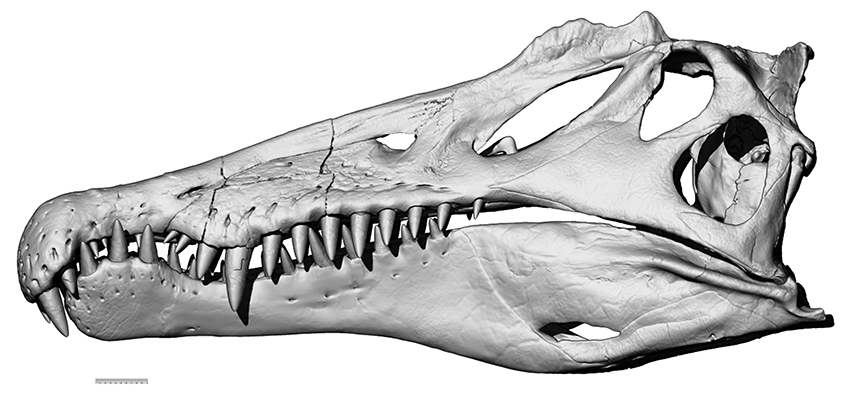Modern paleoart is about exploration, I think, exploring ideas and theories and speculations, that may well be wrong - but perhaps striving for absolute accuracy is not right. Nothing will ever be 100% accurate, but speculation adds a certain intrigue and fun aspect to paleontology that particularly draws me to the subject. It allows us to visualize ideas and see what might be possible.
Which brings me to my topic - just how far can we go? How much speculation is too much? I think my answer to this is, we need more wild speculation! Paleontologists and paleoartists are increasingly allowing themselves to speculate more, but I think we could this even more. If we open the floodgates to wild ideas, then we may suddenly find ourselves realising that these concepts are not so wild - but actually surprisingly plausible looking at modern creatures.
Let us, for a moment, look at modern day creatures which have unusual features - I'll stick to soft tissue, as this is where most of the speculation I am talking about is centered. There are countless examples of bizarre animals that would seem mundane without their strange features - yet look at their skeletons, and there is scant evidence for their unusual external appearances.
I'll label the photos, the reason for which will become apparent further down the post.
My first example is the star-nosed mole. Its snout bears bizarre appendages, rather like tiny, stubby tentacles. There are 22 of them, fleshy and sensitive, and filled with 25,000 sensory receptors, known as Eimer's organs. Without this feature, then the star-nosed mole would barely be of note - its rather like other similar mole species. Yet if you stripped away the flesh and left only the bones - or better yet, an incomplete fossil - then the chances of its bizarre nose appendages leaving any trace is very slim. We would have no idea that it had these organs, and would classify it as a rather regular mole.
1
As can be easily seen in just these few examples, animals often look bizarre and sometimes unaesthetically pleasing. Bizarre features can and do exist in modern creatures, and I think that this is something that should be used more in paleoart. For example, picking prehistoric versions of the examples used above, here's some crazy speculations:
Here is a selection of photos showing bizarre soft tissue that shows just how crazy animals can look. They don't give a monkey whether they look cool either . . .
2
Above you can see a female baboon. To demonstrate their receptivity, their buttocks become massively swollen and red.
3
4
5
As can be easily seen in just these few examples, animals often look bizarre and sometimes unaesthetically pleasing. Bizarre features can and do exist in modern creatures, and I think that this is something that should be used more in paleoart. For example, picking prehistoric versions of the examples used above, here's some crazy speculations:
One
The tentacle-like organs on the star-nosed mole got me thinking. It is rare to see such bizarre features on an animal in paleoart, but perhaps some species might have had similar things? One idea that I had, which may be slightly implausible, but isn't impossible - Spinosaurus having sensitive tendrils. Fossilized skulls show tiny nodes lining its jaws, which are similar to pressure receptors known as foramina in crocodiles. What if these nodes actually held small, multifunctional sense organs, like small tendrils, which could sense movement in the water around it (like a crocodile's foramina), but additionally pick up tastes in the water, allowing it to hone in on the exact location of its prey. This is just a quick and not very well developed idea.
The foramina can be seen on the skull as small dots lining the jaws.
Two
It is not so hard to imagine some dinosaur species using signals to show their receptivity to mating. For ones with a good sense of smell, I believe scents may have been used - I'll look into that some more in an other post. Some probably had set times of the year when mating would have taken place, rather than a sporadic reproduction, in which case some kind of signal would be required to show the readiness to mate. Some species may have shown this visually with swellings or colour changes in facial ornamentation.
Three
The king vulture shown here has a lot of colourful facial display structures. As these take around 4 years to fully develop, and it is not until 4-5 years of age that they become sexually receptive, it seems quite likely that it demonstrates sexual maturity. I think that a lot of non-avian dinosaurs had such facial ornamentation, in the form of fleshy erectile tissue, wattles, carunculations, and other more bizarre structures that I may delve into at a later dtae. I'll post a lot more information in later posts.
Four and Five
The 4th picture shows a Bulwer's pheasant, the 5th a Temmink's tragopan. Both show prominent erectile tissue in the males, which can be expanded during mating displays, but then can retract so as to not get in the way during everyday life. Such tissue may have been in several species of dinosaurs, as I really think such avian display structures are underused in paleoart.
So there, some food for thought. Paleoart can push the boundaries, and perhaps it could do so to a greater extent then it already does. One day I would very much like to see a tendril-faced Spinosaurus, or a hadrosaur with erectile display structures.
So there, some food for thought. Paleoart can push the boundaries, and perhaps it could do so to a greater extent then it already does. One day I would very much like to see a tendril-faced Spinosaurus, or a hadrosaur with erectile display structures.


_-_Weltvogelpark_Walsrode_2013-01.jpg)


No comments:
Post a Comment
Note: only a member of this blog may post a comment.